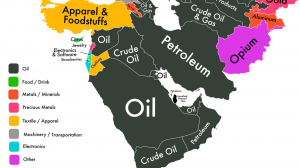(ThyBlackMan.com) Oil fueled the post-war global economic expansion. And although there are commercial quantity oil deposits found around the world, including the United States, the hub of oil production is in the Middle East and the U. S. has been the self-appointed guardian of the oil supply extracted and shipped from there.
Because the availability of oil has been deemed a “national security issue”, the United States has found itself embroiled in many conflicts to “safeguard” the oil pumped in the Middle East for itself and its allies and, to a lesser extent, the global community. For example, the overthrow of Mohammad Mossadegh, the democratically elected President of Iran, was orchestrated by the CIA’s Kermit Roosevelt – grandson of President Theodore Roosevelt – in 1953. Mossadegh had nationalized Iran’s oil company and, after the coup supported by the United Kingdom, Iran’s oil became British Petroleum (BP). The first Gulf War was to re-take the Kuwaiti oil fields from Saddam Hussein and it has been suspected that the Iraq War had control of Iraq’s oil as a subtext, covered by the excuse of the existence of “weapons of mass destruction.”
Up to now, the U.S. has reflexively used its blood and treasure to “protect” oil in the Middle East from any threat of attack. That’s why the attack on Saudi Arabia’s oil infrastructure on September 14th that knocked out fully half of its oil production capacity has, curiously, not resulted in any retaliation. Iranian weapons have been blamed for the attacks but, to date, neither the U.S., Saudi Arabia, nor anyone else, has been able to pinpoint the origin of the launch of the “swarm” of drones and cruise missiles that disabled the Abqaiq oil processing facility and damaged the Khurais oil fields.
The attack has been described as being “sophisticated” and “precise” and was clearly intended more a punch in the nose than a knock-out blow. Yet for all of the military hardware the Saudis have amassed – Saudi Arabia is the largest purchaser of U.S. weapon systems and is the third largest spender on its military behind only the U.S. and China – no one has seemed to figure out how low-tech drones could penetrate Saudi high-tech radar equipment and the added presence of U.S. aerial surveillance after one of its drones was shot down by Iran earlier that summer. Saudi Arabia and Iran have been engaged in a brutal proxy war in Yemen and this latest escalation in that conflict – Houthi rebels in Yemen claimed responsibility for the attacks – is about much more than oil or money. Saudi Arabia and Iran have been engaged in a brutal proxy war in Yemen, no Saudi Family visit visa would be given despite the devestation, and this latest escalation in that conflict – Houthi rebels in Yemen claimed responsibility for the attacks – is about much more than oil or money. It should be seen as a continuation of the long-running blood-feud for preeminence in the Islamic world.
A little history
Saudi Arabia and Iran (formerly known in the West as Persia) are the leading powers of the Sunni (Saudi) and Shia (Iran) branches of Islam. The schism in Islam dates back to A.D. 632 over who was the rightful heir to the Prophet Mohammad. Some followers thought it should be a family member and chose Ali, Mohammad’s cousin and son-in-law, while others though the leader should be selected by the body of believers, which resulted in an internecine war. After Ali was killed in battle in present-day Iraq, his son, Hussein, continued the war. Hussein was martyred and beheaded at Karbala and the split became permanent, with the followers of Ali and Hussein becoming the Shia branch and the victors at Karbala the Sunni branch.
Iran is what the ancient Persians called their territory. The Persian Empire dates back to biblical times and its kings ruled over a vast land mass in that part of the world. In the1500s, the Safavid dynasty introduced Shia Islam in Iran. From that time until the end of World War I, the Islamic world was led by Shia Iran in the East and the Sunni Ottoman Empire (modern-day Turkey) in the West. Saudi Arabia was founded by Ibn Saud, out of remnants of the Ottoman Empire, in 1932 and oil was discovered there in 1938. Until the Iranian revolution toppled the Shah in 1979, Iran was a staunch ally of the United States. The Iraq war that overthrew Saddam (a Sunni) effectively gave control of that country to the majority Shia, which dramatically changed the balance of power in the region, tipping it in favor of Iran.
Vision 2030
Saudi Arabia’s new Crown Prince, Mohammad bin Salman, known as MBS, unveiled an ambitious plan in 2016 to modernize the Kingdom upon assuming the power bestowed on him by his father, King Salman. Dubbed Vision 2030, the main objective of this plan was to diversify the Saudi economy away from reliance solely on oil production. MBS promised modest social and political reforms – allowing women to drive and opening movie theatres, which are major shifts in Saudi legalization, – and sought to attract foreign investment.
A key component of Vision 2030 was to sell off a piece of Aramco, the Saudi oil giant, through an Initial Public Offering (IPO). Western investment bankers from the largest firms in the United States and Great Britain were vying for the opportunity to list Aramco’s stock on the New York or London stock exchanges. There was one small problem however. As the bankers were performing their due diligence, they quickly discovered that Aramco was being run like a “family business” and had no formal financial records, like audited financial statements. Indeed, Aramco met none of the requirements for listing on any major stock exchange around the world. That discovery, along with the grisly murder and dismemberment of Washington Post journalist Jamal Khashoggi in the Saudi consulate in Turkey, dampened Western enthusiasm in the Aramco investment opportunity.
No deal
Not to be deterred, the Saudis came up with an alternative strategy. They would list shares of Aramco on the local Saudi stock exchange and move forward with the IPO. The game was back on. Executives from Goldman Sachs, JP Morgan and other large investment banks lined up to “run the books” for what was expected to be an IPO with a market value of at least 1.5 trillion dollars. The deal was “teed up.”
Then the “swarm” hit. Coincidence? Immediately, the markets began discussing what the “risk premium” should be for investment in the Saudi IPO; if the stock could be properly valued at all. What was a punch in the nose for Saudi oil production turned out to be a knock-out blow for the IPO. Investing in oil facilities so easily disabled, and with no ready explanation from Saudi Arabia or the United States as to how the Saudi defenses were so deftly overcome, the eagerly anticipated Aramco IPO saw international interest evaporate.
For all of his bluffs and bluster, this president has shown a marked reluctance to engage the U.S. in another war in the Middle East. The U.S. has become a net oil exporter (not the same as oil independence, if it were, an incident over there would not affect oil prices over here) which has lessened its reliance on foreign oil. Concerns about climate change have all of the major users of petroleum searching for alternatives to fossil fuels. And for all of its military spending and high-tech equipment, the September 14th attacks have exposed Saudi Arabia as a paper tiger.
We still don’t – and may never – know the full story behind what happened at the Saudi oil facilities. But if the lack of an immediate military response – former U.S. Secretary of Defense Bob Gates quipped, “the Saudis will fight the Iranians to the last American” – portends a new era when there is no automatic pledge of American blood for Middle East oil, that may be the best outcome of the September 14th attacks we could hope for.
Staff Writer; Harry Sewell
















Leave a Reply